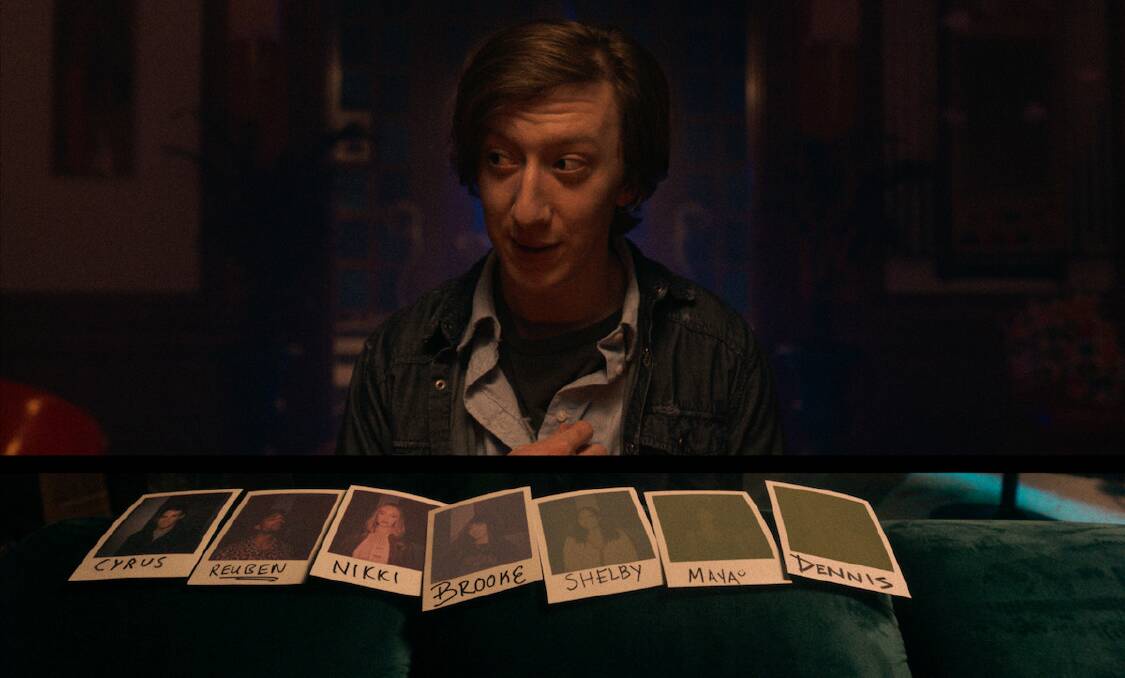watching It's What's Inside

Well, I watched both movies like I said I would, a double feature. I'd been fearful about tornados hitting my cats, residence, and family, who are all located on the Florida peninsula, so I finally hunkered down into bed myself, as if it were a dark and stormy night here in California.
First I watched Bodies Bodies Bodies (since it is a queer Agatha Christie mystery set during a "hurricane party," an elevator pitch I found inherently soothing), then I watched It's What's Inside.
I have a lot to say about the first movie, and very little to say about the second, so I'll actually talk about the second (instead of losing a week to the first one). First I will say that, even though it is a "Netflix" movie—starring a stable of young adult actors who have appeared in other Y.A. offerings like Chilling Adventures of Sabrina and R.L. Stine's Fear Street—it deserves a little better than its current IMDb score of 6.6. (Skimming the user reviews reveals the unreliability of score averages; there are 1s mixed in with the 8s.)
I think what struck me most was that the ensemble cast itself is very, very good—each punching well above the movie's genre category (it's giving "range"). Speaking as a viewer who can't remember names or faces, I had no difficulty following the "action" (and I would've survived even without the director's red-tinted reminders), because the actors were just that good at communicating who they were. All I wanted was more, more of everything; that's the problem with good ideas.
It's What's Inside is a lot like its companions Coherence and The Invitation. But I also saw it being compared to Bodies Bodies Bodies (??) and Primer (???????). I keep trying to figure out that last one. I guess if you think of Shane Carruth's character as 5 different characters?, instead of one guy from 5 timelines in the fight of his life against himself?? It's What's Inside has more in common with the reality competition show The Traitors; the intrigue comes from each of the characters figuring out who they'll have to step on in order to get what they want. (If you've ever watched David Mamet's Masterclass video series about screenwriting, he claims that every line of dialogue needs to be about "what I want" or "how I'm gonna get it." I've never decided if that's good advice or not, and I suddenly forget the actual book he's paraphrasing, but Mamet repeated it so often in the videos, it's now burned into my mind. It's What's Inside follows that prescribed template really well; doing so is a very good way to maintain the intensity and momentum of a suspense movie.)
What It's What's Inside really shares in common with Bodies Bodies Bodies is a bad ending. (I liked the ending of Bodies Bodies Bodies, but I wouldn't begrudge anyone for going "oh" instead of "ahhhh.") There's always a final step in a "whydunnit," and that final reveal rarely hits the spot for the viewer. No matter the reason we're given, we're gonna be like "oh, that's not a very good reason for all that to've happened." (Which is obviously the point—but if you've spent two hours working on figuring out which of the motives sound good enough to drive you to murder, you're not gonna love any of the answers.) Inhuman motivations—alien or supernatural reasons—can land well with viewers. When it first came out, a New Yorker review claimed The Sixth Sense ended so well, the ending had fooled audiences into thinking they'd just seen a better movie than they really had.
The endings of both Primer and Ring are chilling because they end by showing us a character's sudden new motivation, a brand-new strategy, and what their new arc will mean for everyone else (including, potentially, the viewer themselves). I also especially enjoy the "nothing has changed" "actually, now things are a little bit worse" movie resolution—the bleakness of The Graduate, for example, which has far too long been unrecognized and underappreciated as an actual, literal zombie movie.